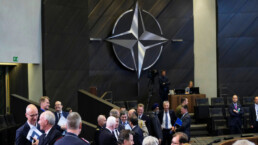For a longterm peace, the region needs new security structures outside of the alliance that eventually include Russia.
By George Beebe, Responsible Statecraft
Amid a precarious proxy war with Russia, a brewing crisis with China, and a potential confrontation with Iran – not to mention considerable turbulence at home – Americans can at least take comfort in knowing that the NATO alliance is continuing to expand.
Or at least, that appears to be the message coming out of Washington.

On Tuesday President Joe Biden signed U.S. ratification documents for Sweden and Finland to join NATO, with overwhelming bipartisan approval from both chambers of Congress. So far, 23 of the 30 members of the alliance have ratified the applications, as NATO moves to expand in response to Putin’s brutal full-scale invasion of Ukraine. At the signing ceremony in the White House, Biden remarked, “Putin thought he could break us apart…instead, he is getting exactly what he did not want.”
One might hope that NATO’s strategy consists of more than doing what Putin does not want. But there is little sign of that in its new Strategic Concept. It offers a plan for stationing more U.S. forces in Europe and expanding NATO’s quick reaction forces by a factor of more than seven. It reiterates NATO’s position that Ukraine and Georgia will one day become NATO members. It also suggests that the alliance regards China, as well as Russia, as a threat and needs to devote more attention to the Pacific.
Recent Posts
‘Unconstitutional. Unethical. Authoritarian.’ ICE Bars Millions Of Immigrants From Bond Hearings
July 18, 2025
Take Action Now One watchdog said the new policy “seems like a blatant attempt to stop them from exercising their right to due process.”……
Americans Are Not Nearly Alarmed Enough About Climate Change
July 18, 2025
Take Action Now Americans still don’t comprehend how imminent, dangerous, and far-reaching the threat is—and journalists are partly to blame.By…
The IRS Is Building A Vast System To Share Millions Of Taxpayers’ Data With ICE
July 17, 2025
Take Action Now ProPublica has obtained the blueprint for the Trump administration’s unprecedented plan to turn over IRS records to Homeland Security…
Israel’s Sudden Assault On Syria Is Unchecked Aggression
July 17, 2025
Take Action Now Jerusalem is bombing Damascus and threatening al-Sharaa’s rule, while Washington was hoping to help the nascent government on…




